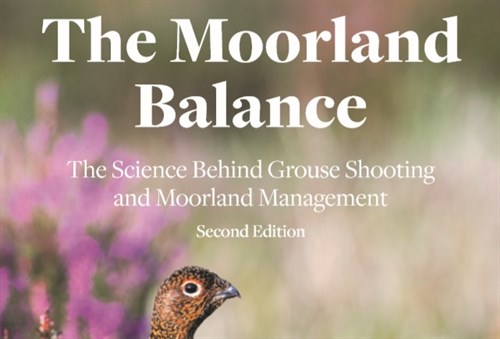Key points
- On Langholm Moor, reduced sheep grazing was associated with increased heather cover between 2008 and 2015.
- Red grouse densities were higher in areas with more heather, but they did not breed or survive better.
- Management for red grouse (predator and disease control, heather burning and cutting) had a larger effect on red grouse densities than grazing reductions and the associated heather recovery.
- Increasing heather cover can help support more red grouse, but only if breeding success and survival can be increased.
Background
 Red grouse in Britain are closely associated with heather moorland. However, widespread loss of this heather habitat has occurred during the 20th Century because of overgrazing and afforestation, and this has been associated with red grouse declines.
Red grouse in Britain are closely associated with heather moorland. However, widespread loss of this heather habitat has occurred during the 20th Century because of overgrazing and afforestation, and this has been associated with red grouse declines.
Langholm Moor was managed both as a grouse moor and as a sheep farm until 1999, when grouse moor management stopped and sheep grazing became the primary land use. Due to heavy grazing by sheep, heather cover on the moor declined by almost half between 1948 and 1988, and continued declining until at least 2007.
In 2008, grouse moor management restarted on Langholm Moor, with the aim to restore the heather habitat and increase grouse numbers for driven shooting. To help heather restoration, sheep grazing was stopped on most of the heather habitat in 2011, heather was re-seeded on some areas of grass-dominated moorland, and patches of older heather were burned or cut to encourage regeneration.
This study aimed to find out whether heather restoration at Langholm Moor improved grouse density, breeding success and survival.
What they did
The change in heather cover between 2007 and 2015 was measured from ground vegetation surveys and aerial photographs. Red grouse were counted using pointing dogs before and after the breeding season to work out density, breeding success and survival. Scientists then tested whether red grouse densities, breeding success or survival were related to estimates of heather cover in the count areas.
Some grouse were also radio-tagged and their survival was studied relative to measures of heather cover within their home range.
What they found
 Reducing sheep grazing and carrying out other restoration measures (burning, cutting and reseeding) increased total heather cover by 10% and the area of heather-dominated vegetation by 30% within six years.
Reducing sheep grazing and carrying out other restoration measures (burning, cutting and reseeding) increased total heather cover by 10% and the area of heather-dominated vegetation by 30% within six years.
Densities of red grouse were higher in areas with more heather. However, there was no relationship between heather cover and red grouse breeding success or survival. Survival of radio-tagged birds also showed no relationship with heather cover.
During the early project years, grouse spring densities increased more where heather recovery was greatest. This may be because restored grouse moor management led to increased breeding success, with the juveniles settling in areas with more heather. During the later years, when heather recovery accelerated after grazing reductions in 2011, grouse spring densities did not respond to increases in heather cover.
What does this mean?
 This is the first study looking at the response of red grouse to changes in heather cover within the same site. Previous studies have looked at differences between moors, where other factors may have also contributed to variation in the red grouse population.
This is the first study looking at the response of red grouse to changes in heather cover within the same site. Previous studies have looked at differences between moors, where other factors may have also contributed to variation in the red grouse population.
Overall, management for grouse (predator and disease control, heather burning and cutting) had a larger effect on red grouse density than reduced sheep grazing and the associated heather recovery. The results of this study suggest that heather restoration has the potential to increase grouse-carrying capacity in the long-term. However, realising this potential relies on also improving grouse breeding success and survival, which were suppressed by predation at Langholm.
It is sometimes assumed that habitat restoration will lead to bird population recovery. However, the results of this study are consistent with other studies suggesting that habitat restoration alone may be insufficient to increase numbers in situations where populations are affected by other factors, such as predation.
Read the original paper
Ludwig S., Aebischer N., Bubb D., Richardson, M., Roos S., Wilson J. & Baines D. (2018) Population responses of Red Grouse Lagopus lagopus scotica to expansion of Heather Calluna vulgaris cover on a Scottish grouse moor. Avian Conservation & Ecology 13(2):14
About the LMDP
This study was part of the Langholm Moor Demonstration Project, a long-running collaboration between the GWCT, SNH, Buccleuch Estates, the RSPB and Natural England, which aimed to resolve the conflict between driven grouse shooting and raptor conservation. Further papers from the Langholm Moor Demonstration Project can be found on the LMDP website.
Photo credit: David Mason

The Moorland Balance - eBook - only £4.99
Get the science behind grouse shooting and moorland management. Building on the success of the first edition, this new and improved version condenses thousands of pages of scientific literature into easy-to-read questions and answers. Over 200 different studies from across the scientific community are referenced in this 134-page book.
View Book >
or
Buy Now - £4.99 >
100% Secure. All Credit & Debit cards, PayPal, Apple Pay and Google Pay accepted.
